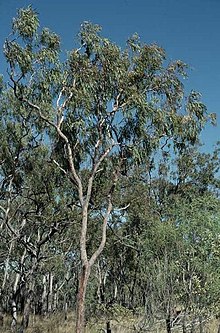Corymbia greeniana is a species of tree that is endemic to northern Australia. It has rough bark on some or all of the trunk and larger branches, smooth bark above, broadly lance-shaped to egg-shaped adult leaves, flower buds usually in groups of seven, creamy white flowers and urn-shaped fruit with a distinct neck.
Corymbia arnhemensis, commonly known as Katherine Gorge bloodwood, is a species of slender tree that is endemic to the Top End of the Northern Territory. It has rough bark on some or all of the trunk, sometimes the larger branches, smooth bark above, lance-shaped to curved adult leaves, flower buds in groups of seven, white flowers and urn-shaped fruit.

Corymbia dichromophloia, commonly known as small-fruited bloodwood, variably-barked bloodwood or gum-topped bloodwood, is a species of tree that is endemic to northern Australia. It has smooth white bark sometimes with flaky bark on the trunk, lance-shaped adult leaves, flower buds usually in groups of seven, creamy white flowers and urn-shaped fruit.

Corymbia eremaea, commonly known as mallee bloodwood, hill bloodwood and Centre Range bloodwood, is a small, mallee-like tree that is endemic to central Australia. Indigenous Australians know the plant as muur-muurpa. It has rough, evenly tessellated bark, lance-shaped leaves, oval to pear-shaped flower buds arranged on a branching peduncle and urn-shaped fruit.

Corymbia erythrophloia, commonly known as red bloodwood, variable-barked bloodwood, red-barked bloodwood or gum-topped bloodwood, is a species of tree that is endemic to Queensland. It has rough bark on the trunk and branches, egg-shaped or lance-shaped adult leaves, flower buds in groups of seven, creamy white flowers and urn-shaped to spherical fruit.
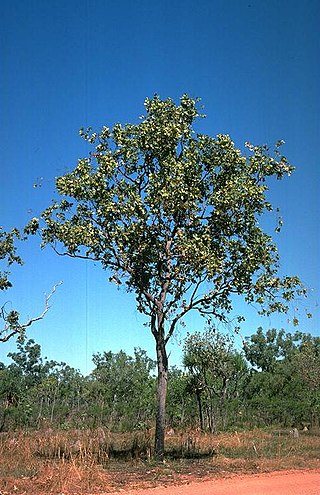
Corymbia ferruginea, commonly known as rusty bloodwood, is a species of tree that is endemic to northern Australia. It has rough, tessellated bark on the trunk and branches, a crown of sessile juvenile leaves, flower buds in groups of three or seven, pale creamy yellow flowers and urn-shaped fruit.

Corymbia foelscheana, commonly known as broad-leaved bloodwood, fan-leaved bloodwood or smooth-barked bloodwood, is a species of small tree that is endemic to northern Australia. It has thin, rough, tessellated bark on some or all of the trunk, smooth bark above, broadly egg-shaped to broadly lance- shaped adult leaves, flower buds usually in groups of seven, creamy white flowers and urn-shaped fruit.
Corymbia hamersleyana is a species of small tree or mallee that is endemic to the Pilbara region of Western Australia. It has rough, flaky bark on part or all of the trunk, smooth cream-coloured bark above, lance-shaped adult leaves, flowers buds in groups of seven or nine, creamy white flowers and urn-shaped fruit.
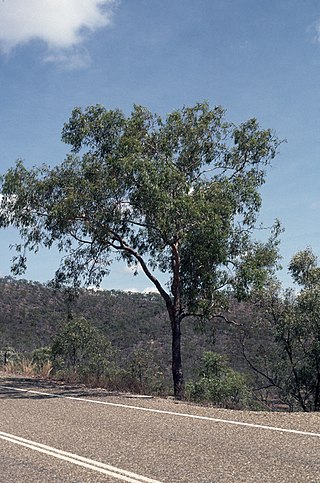
Corymbia hylandii, commonly known as Hyland's bloodwood, is a species of small tree that is endemic to part of the Cape York Peninsula. It has rough, tessellated bark on the trunk and branches, lance-shaped adult leaves, flower buds in groups of seven, creamy white flowers and urn-shaped fruit.
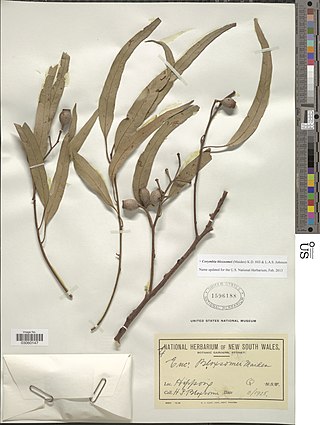
Corymbia bloxsomei, commonly known as yellowjack, yellow jacket or yellow bloodwood, is a species of tree that is endemic to inland, south-eastern Queensland. It has thick, rough scaly bark on the trunk and larger branches, lance-shaped or curved adult leaves, flower buds in groups of seven, nine or eleven, creamy white to pale yellow flowers and barrel-shaped, urn-shaped or spherical fruit.

Corymbia brachycarpa is a species of tree that is endemic to central Queensland. It has rough, tessellated bark on the trunk and branches, lance-shaped adult leaves, flower buds in groups of seven, creamy white flowers and urn-shaped to barrel-shaped fruit.
Corymbia ellipsoidea is a species of tree that is endemic to Queensland. It has rough bark on the trunk and larger branches, lance-shaped adult leaves, flower buds usually in groups of seven, creamy white flowers and barrel-shaped to urn-shaped fruit.
Corymbia lamprophylla, commonly known as shiny-leaved bloodwood, is a species of tree that is endemic to central Queensland. It has rough, tessellated bark on the trunk and larger branches, lance-shaped adult leaves, flower buds in groups of seven, creamy white flowers and urn-shaped fruit.
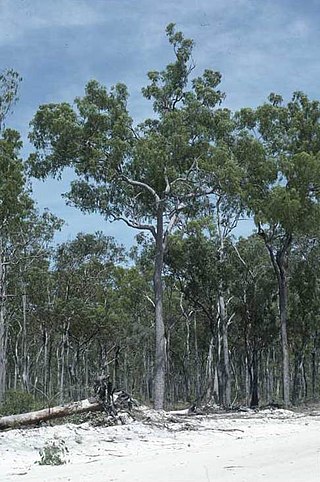
Corymbia nesophila, commonly known as Melville Island bloodwood, is a species of tree that is endemic to northern Australia. It has rough, tessellated bark on the trunk and branches, lance-shaped or curved adult leaves, flower buds in groups of seven, creamy white flowers and urn-shaped fruit.
Corymbia oocarpa is a species of tree that is endemic to the Top End of the Northern Territory. It has thin rough bark on the lower part of the trunk, smooth bark above, lance-shaped to curved adult leaves, flower buds in groups of seven, white flowers and barrel-shaped to urn-shaped fruit.
Corymbia porrecta, commonly known as grey bloodwood, is a species of small tree that is endemic to the Northern Territory. It has rough, tessellated bark on the trunk and branches, broadly lance-shaped to egg-shaped adult leaves, flower buds usually in groups of seven, creamy white flowers and urn-shaped to barrel-shaped fruit.
Corymbia rhodops, commonly known as red-throated bloodwood, is a species of tree that is endemic to Queensland. It has rough, tessellated bark on the trunk and larger branches, lance-shaped adult leaves, flower buds in groups of seven, creamy white flowers with a red centre, and urn-shaped to barrel-shaped fruit.
Corymbia stockeri, commonly known as blotchy bloodwood, is a species of small tree that is endemic to Cape York Peninsula in Queensland. It has rough, tessellated bark on the trunk and branches, lance-shaped adult leaves, flower buds in groups of seven, creamy white flowers and barrel-shaped to urn-shaped fruit.
Corymbia xanthope, commonly known as Glen Geddes bloodwood, is a species of tree that is endemic to a small area of Queensland. It has thick, rough bark on the trunk and branches with yellow bark visible underneath, lance-shaped to curved adult leaves, flower buds in groups of seven, creamy white flowers and urn-shaped fruit.
Corymbia novoguinensis is a species of tree that is native to New Guinea, some Torres Strait Island and the Cape York Peninsula. It has rough bark on the trunk and branches, lance-shaped adult leaves, flower buds in groups of seven, creamy white flowers and urn-shaped to barrel-shaped fruit.
